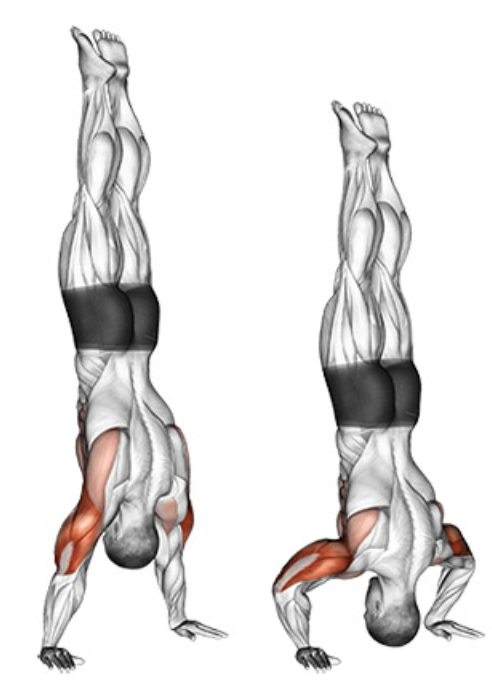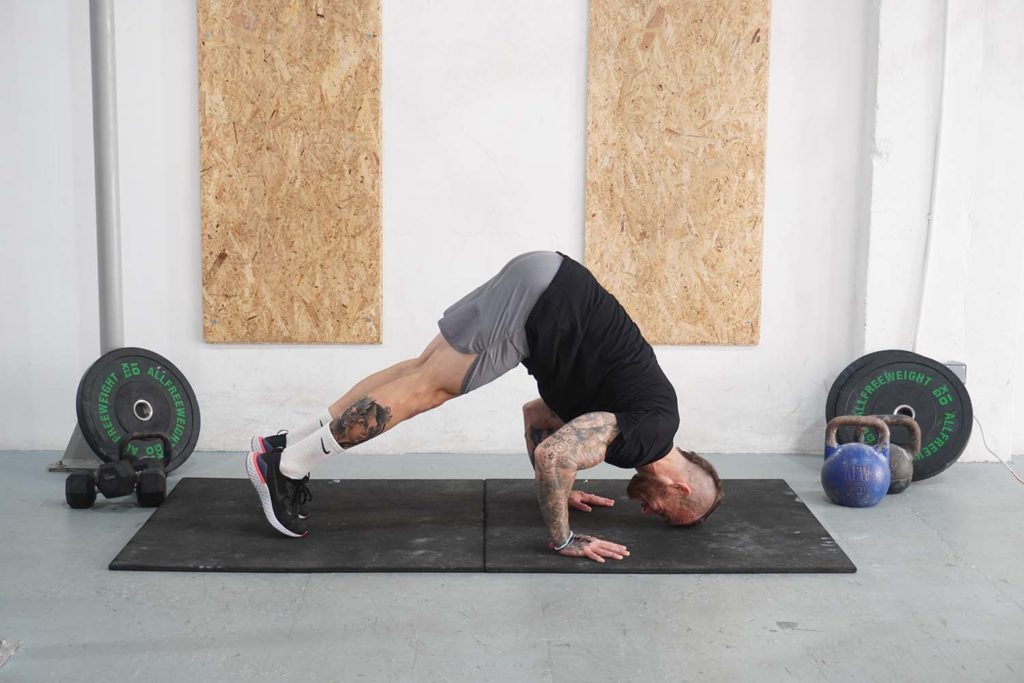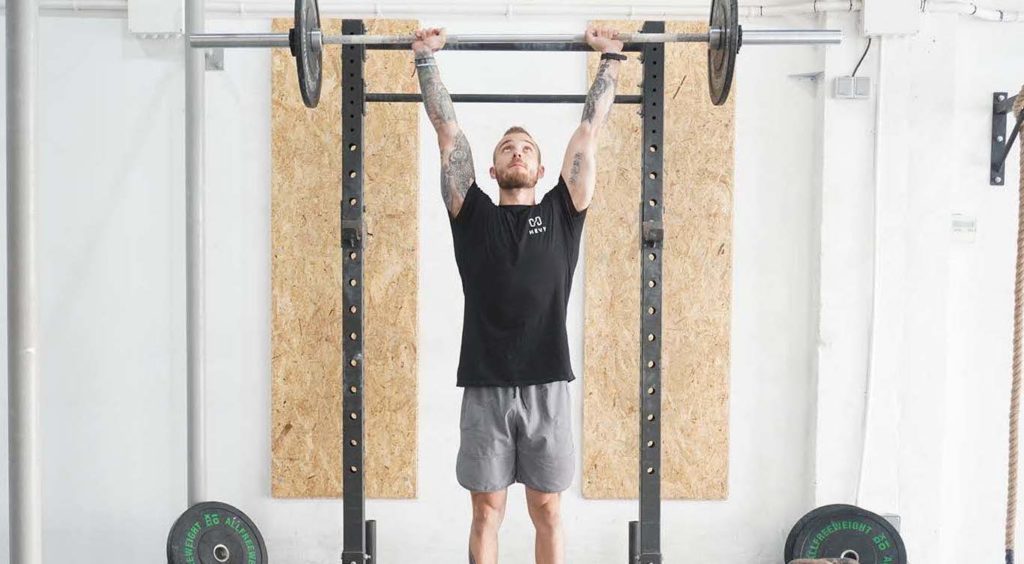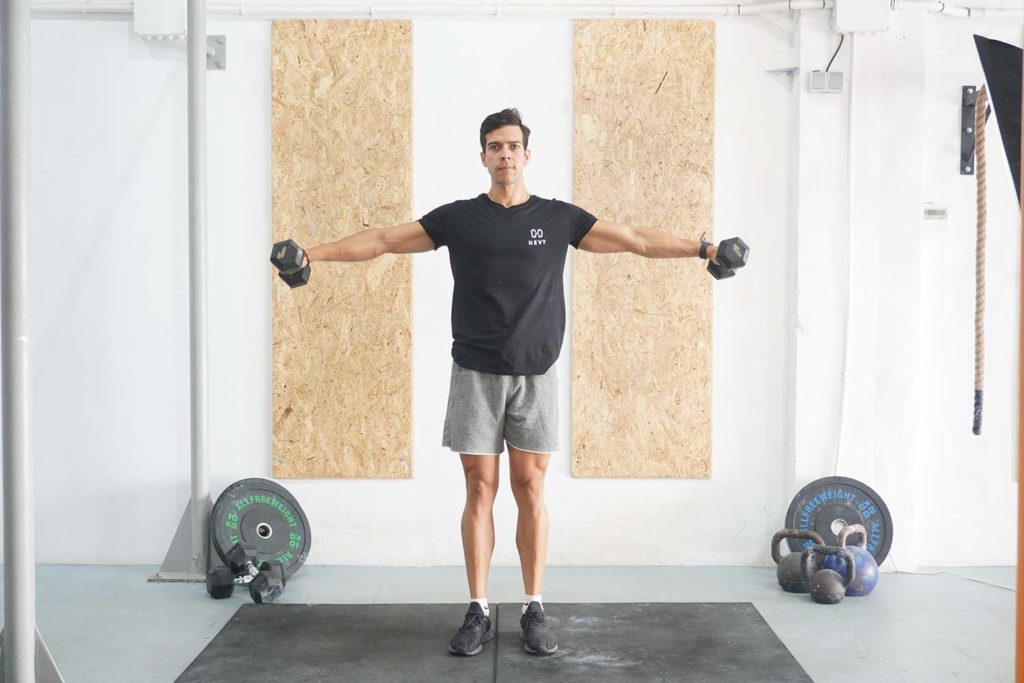What is a Handstand Push Up?
Handstand push ups (HSPU) are one of the most challenging bodyweight exercises you can perform to strengthen your core, shoulders, chest, and triceps. The objective is to stand upside down and support yourself with your hands. You then have to lower yourself by bending your elbows and push back to the top.
The most notable benefit of the HSPU is that it strengthens and develops your shoulders, upper chest, and triceps. HSPUs force you to support 100 percent of your body weight, making your muscles work extra hard. The movement is also fantastic for core strength and stability, given that your midsection has to work extra hard to keep you balanced.
Similar to other advanced exercises (like the front lever raise), HSPUs have several levels of progression, which we’ll go over below. We recommend including handstand push ups early in your training while your upper body is still fresh and strong.
Level of the exercise: Advanced
How to do a Handstand Push Up

- Stand in front of a wall, bend forward and place your hands flat on the floor. Your hands should be slightly wider than shoulder level apart and facing forward or slightly out. The tips of your fingers should be up to ten inches away from the wall.
- Brace your midsection by taking a breath and push through your feet to move up and against the wall. Keep your shoulders and arms engaged as you do so.
- With your body vertical and heels in contact with the wall, keep your midsection engaged and your spine in a neutral position. Keep your arms straight and chin tucked.
- Extend your knees fully and bring your legs together.
- With a rigid position from toes to fingers, take a breath and lower yourself slowly by bending your elbows.
- Go down as much as your strength allows and hold the bottom position for a moment.
- Press yourself back to the top, extending your elbows fully and exhaling.
- Take another breath and repeat.
What muscles does handstand push up activate?
The primary muscles that work during handstand push ups are the deltoids (shoulders). Like an overhead press, the shoulders produce force to bring our arms up against resistance (1). The only difference is that overhead pressing is about lifting external weights, whereas HSPU leverages your body weight.
Our triceps are the second muscle group that works during handstand push ups. The muscle covers the rear of our upper arms and produces elbow extension, which occurs as we push ourselves to the starting position (2).
The upper chest (clavicular head) also contributes to the HSPU as the muscle assists our shoulders and triceps.
Our entire core musculature (rectus and transverse abdominis, obliques, erector spinae, hip flexors, glutes, etc.) also plays an essential role during the movement. These muscles flex isometrically to offer support and keep us balanced as we perform the exercise.
Building Strength to Progress into a Handstand Push Up
Performing the HSPU is about having two things: strength and stability. Lacking either would prevent you from doing the exercise effectively.
A good way to develop the necessary strength for handstand push ups is to perform several key movements consistently: overhead press, upright row, lateral raise, close-grip bench press, and similar. Doing these movements will strengthen the involved muscles enough for you to start doing the HSPU.
Aside from that, working on your stability will also play a role in your success. All the strength in the world won’t do you much good if you can’t stay balanced as you do the exercises. Movements like the plank, reverse plank, hip thrust, glute-ham raise, and hanging knee raise will strengthen your midsection and improve your stability.
Following a pike push up progression will strengthen all the muscles involved in a handstand push up. Begin with the pike push up and increase your foot elevation over several weeks. Start with your feet on the floor, move up to a gym bench, a high chair, and eventually––the kitchen counter. The more you elevate your feet, the closer you get to the HSPU.
Variations and Modifications of the Handstand Push Up
1. Pike Push Up

As briefly mentioned above, pike push ups are an effective exercise you can perform as part of your progression. The objective is to assume an inverted V position with your hands and feet on the floor and buttocks elevated to the ceiling. The position allows you to emphasize your shoulders instead of your chest while moving up and down.
2. Handstand Push Ups On Parallettes
Performing handstand push ups on parallettes is a great way to make the movement more challenging and effective. Using stands increases the range of motion and prevents you from bumping your head into the floor.
3. Handstand Push Up Negatives
Handstand push up negatives are another neat variation you can use to build upper body strength. The objective is to assume the handstand position and lower yourself as slowly as possible. Then, extend your body, get into the top position again, and lower yourself.
Mistakes to Avoid
One of the most common mistakes with the handstand push up is placing your hands too close to the wall. Doing so might seem fine, and you can still assume the correct position. But as soon as you start moving down, your buttocks will push you against the wall. Avoid the mistake by placing your hands at least eight to ten inches away from the wall before assuming the handstand position.
The second mistake with the HSPU is never using parallettes. Doing so isn’t bad at the start when first learning the movement, but it can hinder your progress down the road. Using parallettes or finding another way to elevate your hands is vital for increasing the range of motion and training your shoulders more effectively.
The third mistake to watch out for with handstand push ups is doing reps too quickly. Speed might allow you to do a few extra reps on each set, but it makes the exercise more challenging to balance. Plus, it increases the risk of hitting your head on the floor.
Avoid the error by performing each repetition slowly and with excellent body control. That way, you can keep your muscles under tension for longer, forcing them to grow and strengthen more effectively.
Similar Exercises to the Handstand Push Up
Standing Military Press (Barbell)

Standing barbell presses are a fantastic exercise that strengthens many of the same muscles you work during HSPUs (1). The movement is great because you can adjust the resistance based on your strength and gradually improve your abilities, making it easier to do handstand push ups down the road.
Lateral Raises (Dumbbell)

Though not the same as a handstand push up, lateral raises are fantastic. The exercise isolates your deltoids, forcing them to grow and strengthen (3). Performing lateral raises is also helpful for improving shoulder stability, leading to more athleticism and lower injury risk.

